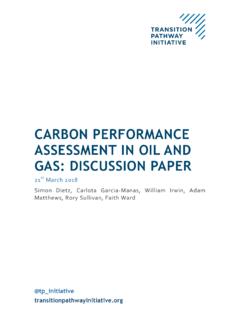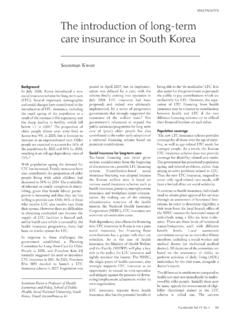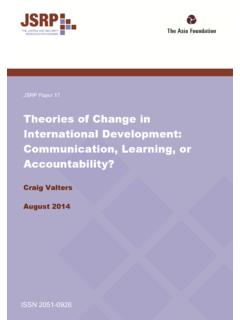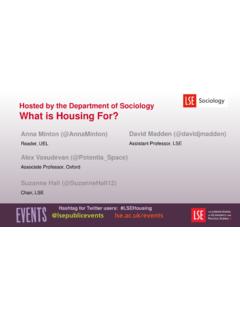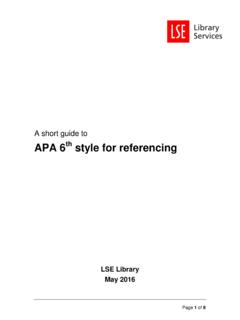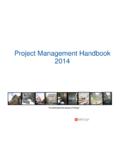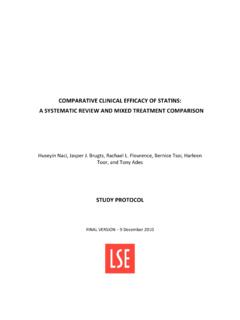Transcription of From Digital Skills to Tangible Outcomes project report
1 Measuring Digital Skills From Digital Skills to Tangible Outcomes project report Alexander van Deursen, Ellen J. Helsper and Rebecca Eynon 2014 Measuring Digital Skills From Digital Skills to Tangible Outcomes project report When quoting this report please use the following reference: Van Deursen, , Helsper, & Eynon, R. (2014). Measuring Digital Skills . From Digital Skills to Tangible Outcomes project report . Available at: Correspondence Alexander van Deursen E-mail Web Correspondence Ellen Helsper E-mail Web Correspondence Rebecca Eynon E-mail Web Acknowledgements The authors are grateful for financial support for this project from the John Fell Fund (University of Oxford), the Department of Media and Communications (London School of Economics and the Department of Communication science (University of Twente) TABLE OF CONTENTS Tables and Figures.)
2 6 1. INTRODUCTION .. 7 2. LITERATURE OVERVIEW .. 9 Conceptualization of Internet Skills .. 9 Methods employed to measure Internet Skills .. 10 Scales used to measure Internet Skills .. 11 Measuring Internet Skills .. 12 3. COGNITIVE INTERVIEWS .. 15 Procedure .. 15 Results .. 15 4. SURVEY PILOT TEST RESULTS .. 17 Exploratory analysis .. 17 Discriminant validity .. 24 Confirmatory factor analysis and invariance .. 25 Conclusions .. 26 5. POPULATION SURVEY TEST RESULTS .. 27 Sampling .. 27 Confirmatory factor analysis .. 28 External validity .. 29 Conclusions .. 34 6. MEASURING Digital Skills : CONCLUSIONS .. 37 REFERENCES .. 41 44 TABLES AND FIGURES Table Internet Skills items based on theoretical framework.
3 12 Table 2. Demographic profile UK and NL Internet users pilot sample .. 17 Table 3. Full scale characteristics .. 18 Table 4. Short scale characteristics .. 18 Table 5. Correlations between full scales .. 19 Table 6. Chi-square differences (df=1) for paired construct test .. 25 Table 7. Factorial invariance tests (Operational, Information Navigation, Social and Creative scales) .. 25 Table 8. Model fit on CFA for the individual factors .. 25 Table 9. Demographic profile Dutch Internet user sample .. 27 Table 10. Scale characteristics in Dutch Internet user 28 Table 11. CFA fit for long and short scales in the Dutch population .. 28 Table 12. Short scale characteristics in the Dutch population .. 29 Table 13. Factor correlation and AVE2 (on diagonal).
4 31 Table 14. Convergent and discriminant validity indicators Skills scales .. 31 Table 15. Reliability ( ) of short Skills scales in different groups .. 32 Table 16. Correlations between short scales in population survey .. 33 Table 17 Proposed items and factors to measure Internet Skills .. 38 Figure 1. Ten item Operational Skills scale .. 19 Figure 2. Three item Mobile Skills scale .. 20 Figure 3. Eight item Information Navigation Skills scale .. 21 Figure 4. Six item Social Skills scale .. 22 Figure 5. Eight item Creative Skills scale .. 23 Figure 6. Skills comparison for Gender and Age groups .. 29 Figure 7. Skill averages for different education groups .. 30 Figure 8. Skills averages by occupational group .. 31 Measuring Digital Skills From Digital Skills to Tangible Outcomes project report | 7 1.
5 INTRODUCTION As the Internet becomes part of everyday life, policy makers have developed a range of initiatives to try to ensure that all individuals have Internet access to benefit from a wide range of online learning, employment, networking, and informational opportunities. Simultaneously, academic research in this field has proliferated rapidly, and we now have a great deal of research that demonstrates the complexity of factors that help us understand how and why people use the Internet. However, there is recognition amongst researchers in this field that the measures typically used in empirical work are not sufficiently nuanced. They do not fully reflect current theoretical thinking about Digital inclusion and have not kept up with the changes in the ways that people use and understand the Internet.
6 In 2014, the authors of this report started a project with the main objective to develop an instrument that follows the theoretical model proposed by Helsper (2012). This model hypothesises that the Digital and social are related for similar (economic, cultural, social and personal) types of fields. The influence of offline exclusion on engagement with Digital activities is mediated by access, Skills and attitudinal or motivational aspects; and the relevance, quality, ownership and sustainability of engagement with these activities is said to mediate their influence on offline Outcomes . The project s objective was to develop measures that allow for testing of the model s suggested paths from social to Digital inclusion and vice versa by constructing indicators for Digital engagement and Outcomes and a set of Digital Skills that influences these links.
7 The focus of this report is to propose a set of new measures of Internet Skills . Internet Skills form a key part of Digital inclusion. Yet at present few measures have been developed that examine Skills within a wider framework that makes theoretical links between individuals Skills , types of engagement with online services and activities, and the Tangible Outcomes achieved from this engagement. Our focus on this more holistic view, has led to a search for instruments that are capable of measuring which Skills people have, how these are related to certain types of engagement and how these subsequently might impact specific aspects of everyday life.
8 Such measures are essential in order to properly track who is or who is not digitally included, to assess the effectiveness of interventions designed to support Digital inclusion and to provide better models of the relationships between Internet Skills , engagement and Outcomes . In this report , we focus on measurements for Internet Skills . Further outputs, based on measures of engagements and Outcomes , will follow later in 2014. The main research question is: What is the best set of reliable measures of Internet Skills for use in research, practical, and policy impact evaluation settings? While nationally representative surveys are one of the most appropriate ways to collect data on Internet Skills when testing generalizable models of Digital inclusion, we have found four key challenges with the current measures available: 1) incompleteness often only some Skills are measured and Digital Skills related to more recent web activities are not always fully explored; 2) conceptually blurred as Skills questions can be closely linked to Internet use ( are you good at blogging / how often do you blog).
9 3) over-simplified as Internet Skills are often measured as a 8 | From Digital Skills to Tangible Outcomes project report single dimension; and 4) reliant on self-reported measures that are context dependent and positively biased. The aim of this study is to propose a more elaborate conceptualization of Internet Skills that aims to overcome these challenges, while taking into account the role Skills play in a broader model of Digital inclusion, and test the proposed scales for reliability and validity. In order to construct such an instrument, we took several steps. First, we conducted a systematic literature review of Skills related studies, and developed our Internet Skills framework and associated instrument based on this work (summarised in section 2).
10 Then, we tested this instrument in three stages: cognitive interviews held in the UK and the Netherlands to refine the scales (section 3); online survey pilot tests of the instrument in the UK and in the Netherlands, to test the internal validity of the scales through both exploratory and confirmative factor analysis (section 4); and conducting a full survey in the Netherlands to test the Skills framework for both internal and external validity (section 5). The concluding section (section 6) proposes two types of instruments for Internet Skills : a short version and a more extensive version that could be used in future surveys. The focus on two countries, the UK and the Netherlands enabled the research team to begin to explore the cross-cultural validity of our proposed scale.
